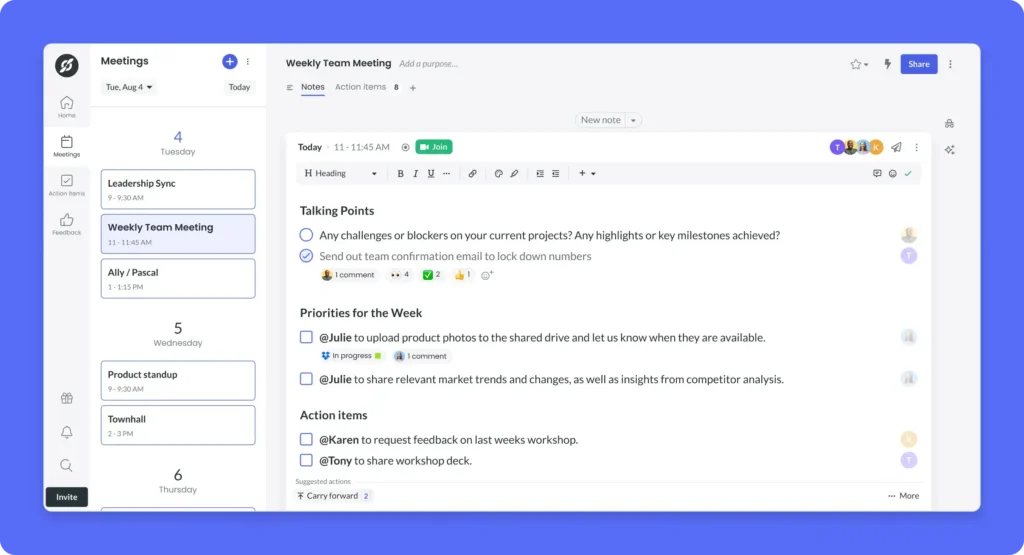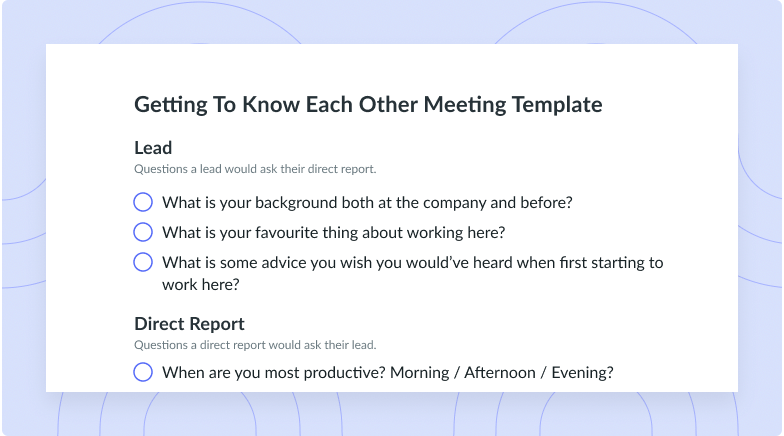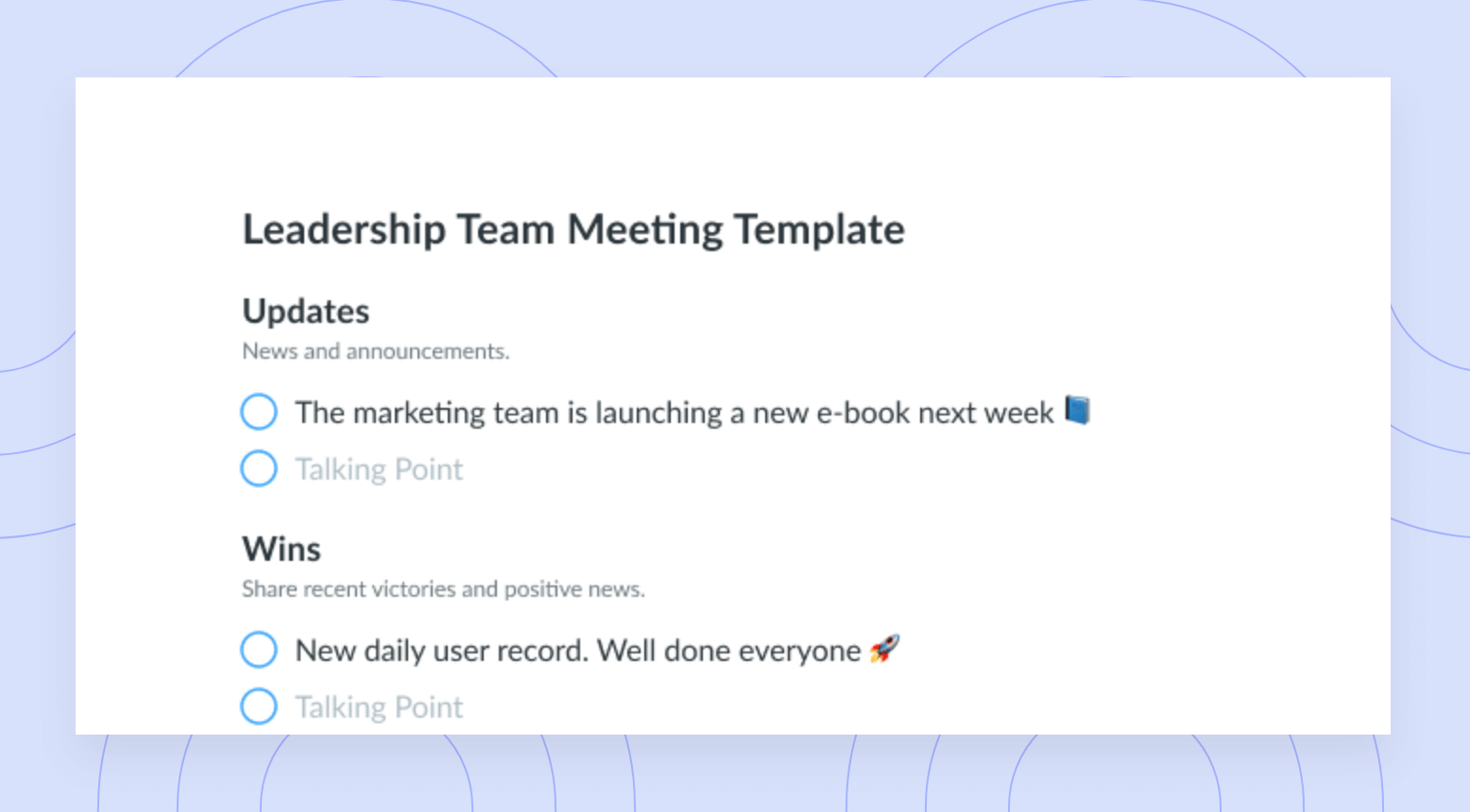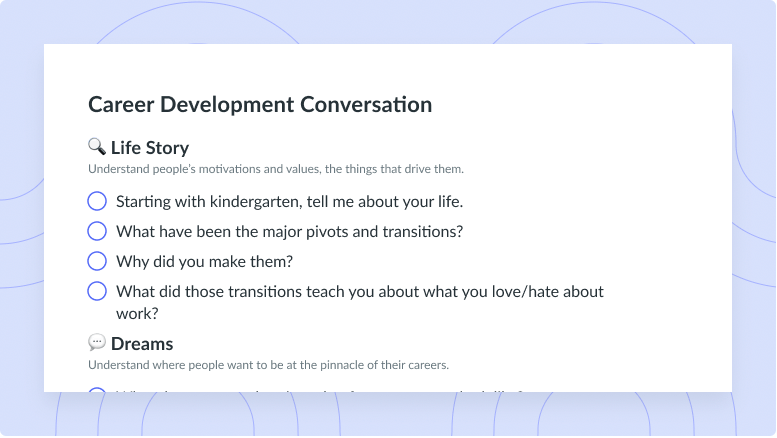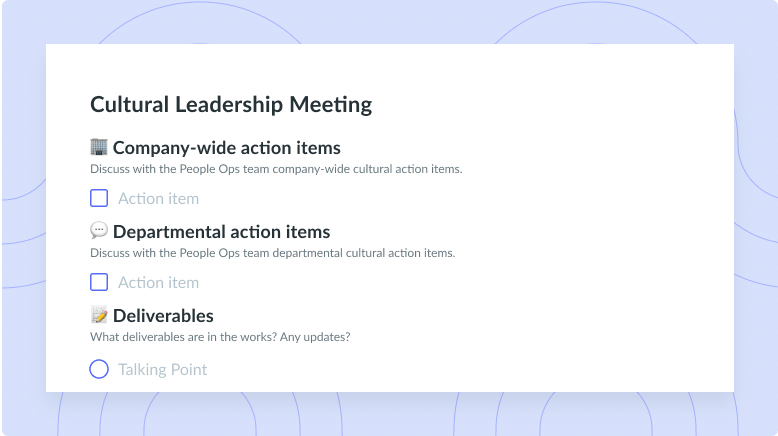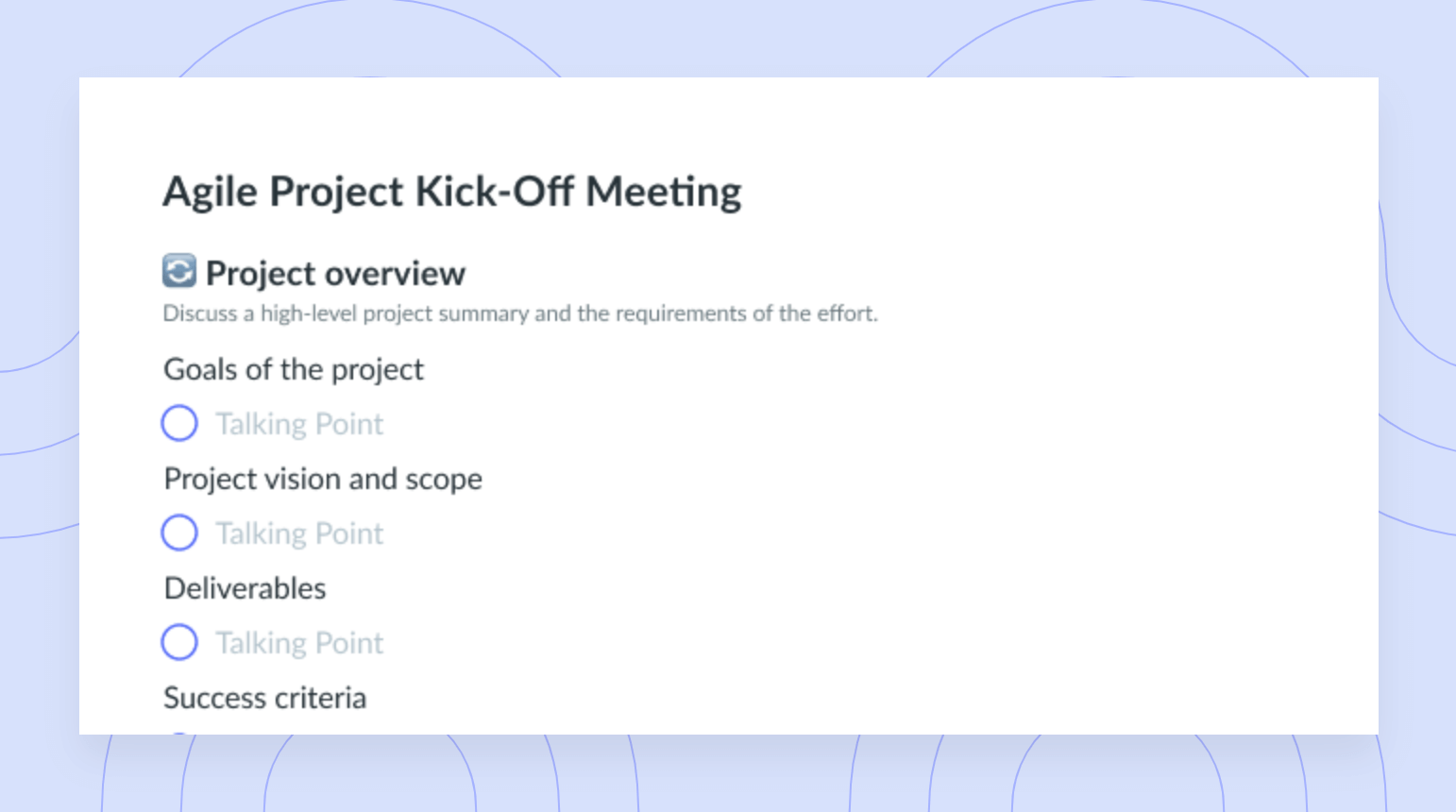Timeboxing in Agile: Scrum, Planning, and Techniques
Timeboxing can help team leaders plan and schedule work within specific timeframes and take all your future projects to the next level.
If your goal is to master project management, increase your productivity, and cut down on wasted time, look no further than timeboxing. This time management technique can revolutionize your workflow, especially if you’re a visual learner who appreciates a more rigid schedule. Keep reading to learn more about all things timeboxing in Agile, including whether it’s right for you and your team.
- Advantages of the timeboxing technique
- Timeboxing in Scrum
- How to start planning your timebox
- How to timebox
- Hard and soft timeboxing
- Unlocking Agile productivity with Fellow
Advantages of the timeboxing technique
Timeboxing is a technique through which you put aside different amounts of time for your different daily tasks. Each task and time allotment gets — you guessed it — a box.
Timeboxing is a great option if you’re a visual learner who prefers to see your schedule laid out (rather than just listing your daily tasks). Below are the top three benefits of the time-boxing technique.
- You’ll be more productive. Timeboxing helps you keep your deadlines front of mind, which in turn helps you stay productive. Organizing your tasks with timeboxing can also help you resist the urge to put things off until the last minute. After all, you wouldn’t want to throw off the schedule you’ve put so much work into organizing.
- You’ll stay focused. Because timeboxing encourages you to work on one task at a time, you’ll naturally stay tuned into solely the task at hand.
- You’ll keep your eye on the time. Let’s be honest—any technique that’ll help you avoid wasting time is worth a shot. Timeboxing can help you protect your time since you’ll know when it’s time to wind one task down and move on to the next one.

Stay on track with your timebox
Say goodbye to meetings that run over their allotted time with Fellow: the all-in-one meeting transcription and management software for remote and hybrid teams. With 500+ meeting templates and an integrated AI Meeting Copilot that transcribes and summarizes your scrum meetings, Fellow ensures your projects are run efficiently and on time, according to the fixed timebox.
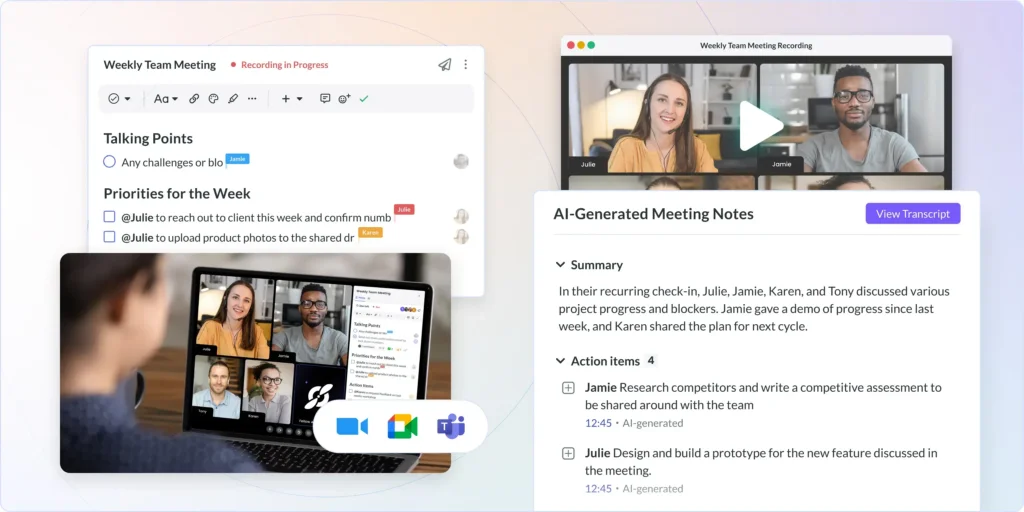
Timeboxing in Scrum
Below, learn all about the five elements of Scrum (an Agile framework) and how timeboxing plays an important role in each.
1Sprints
A sprint is a block of time, typically one month or shorter, for which your team sets a deadline—and makes it. You can use timeboxing to set a sprint’s length. If your sprint is more complex, you can make a timebox for each subtask.
2Sprint planning
An effective sprint always has a robust plan behind it. Sprint planning can help you figure out what—and who—you’ll need on hand to accomplish your tasks.
Always put aside time in your schedule for sprint planning—it’s where timeboxing comes into play. If you’re looking for a frame of reference, try eight hours of planning for a one-month sprint and two hours for a one-week sprint.
3Daily Scrum
When you’re in a sprint, your team will meet for 15 minutes daily to get on the same page. This meeting is called a daily Scrum, and it can make all the difference in reaching your goals efficiently and effectively. During a daily Scrum, you can discuss your short-term goals for the day and any challenges you might encounter.
4Sprint review
After your team wraps up a sprint, look back on how it went. Hold a sprint review to go over the final product, share any highlights and challenges, and give and get feedback. You can use timeboxing to streamline this process and set aside a meaningful amount of time for your review. A great sprint review timebox is half as long as the one for your sprint planning meeting.
5Sprint retrospective
Now that your sprint is fully completed, it’s time to take stock of the entire process—from planning and scrums to your sprint review itself. This sprint retrospective is a great opportunity to discuss what worked during this sprint and what you might want to improve next time.
When you’re timeboxing for this step, allow at least three hours of sprint retrospective time per one-month sprint. This way, you’ll have ample time to cover all your bases.
For this meeting to be valuable and worth the time allotted, leverage an expert-approved meeting agenda like Fellow’s Sprint Retrospective Meeting Template. Created by Certified Disciplined Agile Instructor Gareth Holebrook, this template empowers you and your team to reflect on the sprint, identify past pitfalls, and propose new ideas.

How to start planning your timebox
The following are the key elements to consider when planning a timebox.
1Inspect and analyze
When you’re starting to plan your timebox, take a look at the tasks on your docket. Ensure your goals are realistic and that you’ve allotted enough time to complete each one at full quality. Once you have a handle on your big-picture objectives and the tasks you must complete to accomplish them, you’re ready to begin analyzing them.
Spend time thinking about each task required to complete a project, and determine how you’ll timebox them in Agile. Keep your iterations short—this way, you can assign tasks to the team members best equipped to handle them. This way, nobody will be overwhelmed during your sprints, and everyone can focus on turning in their best work.
2Fill in the gaps
Once you give your analysis a second pass, you might notice that some things that should be in the plan actually slipped your mind. This is why you should test your timebox plan and fill in any gaps.
Get as many eyes as possible on your Agile timebox results. Share them with relevant stakeholders and allow them to give their two cents. This process will help you set your project up for success.
3Consolidate when you can
After receiving stakeholder feedback, you might see some spaces where you can consolidate. Rearranging your timeboxes is a natural part of the process—just make sure that, with any major changes, you run tests again.
If any of your Agile timeboxes expire without you completing the task, you’ll need to create a new timebox. This will lead to a new and improved version of your timebox plan.
4Cover all your bases
From checking your work to drafting up alternative action plans in case things go wrong, take steps to keep your timeboxes as airtight as possible. For example, consider what would happen if you weren’t able to complete a certain step in the allotted time. Would you carry it over to the next step in your timebox, or would you put a pin in it for later? Your answer might change for each task—figure this out before you start your project.
How to timebox
Ready to timebox? Take the five steps below.
- Lay out your tasks
- Set clear goals
- Put time limits on each box
- Cut down on interruptions
- Review, adjust, and add breaks
1Lay out your tasks
Think about the most important tasks in your schedule. Ask yourself: Which ones would benefit from timeboxing? If you know you need a bit more structure when completing certain parts of your project, timeboxing them can help you budget your time. You’ll properly prioritize them and make sure they’re both realistic and done effectively.
2Set clear goals
Once you’ve started shaping your timeboxes, get your entire team clear on what they should achieve within each one. Write out some SMART goals—specific, measurable, achievable, relevant, and time-bound goals. The easier your goals are to understand, the more confident you can be that your team can achieve them.
3Put time limits on each box
Time management is key to creating an effective timebox. Sure, everyone loves to be efficient, but it’s just as important that you’re realistic when setting time limits. After all, you’d hate to cut your deadlines too close and compromise on quality.
If you find yourself stuck on how to allocate your time, explore some time management strategies. For example, you can improve your timebox skills by using Fellow’s Covey time management matrix meeting template. It provides a straightforward framework to help you identify, visualize, and prioritize tasks and decide how much time should go into each one.

4Cut down on interruptions
It’s no secret that you get your best work done when you’re focused, so during each timebox, get comfortable and rid yourself of any distractions. Consider breaking down your goals into smaller, digestible tasks, even within each time block. The best way to minimize distractions truly just depends on what motivates you to do your best work.
5Review, adjust, and add breaks
As you move through your schedule, you’ll get a sense of how accurately your timebox planning went. If you find yourself running out of time for each task, consider making more room later in your schedule. If you find yourself with ample gap time, use it to be productive. Alternatively, use gap time as breaks since downtime is important—meeting breaks, for example, keep you engaged and swerve you away from burnout.
Hard and soft timeboxing
When building timeboxes, one major decision is how much flexibility to include. This is where the difference between hard and soft timeboxing comes into play.
Hard timeboxing
If you opt for a hard timebox, you’re absolutely moving on to the next task once your time is up. If completing every single task in your timebox schedule is your priority, then a hard timebox might be the right fit. Similarly, if you’re one to sweat the small stuff, setting a hard timebox can help you focus on the big picture. Hard timeboxes are all about keeping things moving.
Soft timeboxing
Where a hard timebox features a rigid deadline, a soft timebox allows you some more flexibility. If you’re running a bit over the deadline for a task, soft timeboxing can give you enough time to knock it out of the park.
When you’re a bit unclear on how long a task will actually take your team, then a soft timebox might be the right choice. Plus, if your schedule allows for it, the loose time frames of soft timeboxing give you space to perfect your sprints’ results.
Unlocking Agile productivity with Fellow
Even the best project managers can always use a bit more support. With Fellow’s smart meeting management tools, you’ll take your Agile project management to the next level. Fellow’s meeting guidelines and tools for assigning and syncing trackable action items with PM tools keep your team focused and accountable.
Plus, with access to Fellow’s 500+ meeting agenda templates, you’ll be well-suited to coach your team members on their time management and prioritization skills.
Timeboxing—and project management—doesn’t have to be daunting. Use Fellow to take some of the weight off your shoulders!
